Abstract
A specific treatment plan for management of perforated appendix in children, initiated at the Children's Hospitals in Boston, and later utilized at the Child Health Center in Galveston, has been applied to 143 patients by many surgical housestaff and faculty. The protocol consists of appendectomy, routine use of systemic gentamicin, ampicillin and clindamycin, antibiotic peritoneal irrigation, and transperitoneal drainage through the incision. The average age of the children in this series was 9.1 years (range 14 months to 21 years). The average length of hospitalization was 12.1 days. The use of this protocol resulted in only 11 patients (7.7%) developing significant complications. Complications related to infection occurred in only six of the eleven patients (4.2%). There were no deaths. This protocol of intensive primary therapy can significantly decrease the sequelae from perforated appendicitis in children.
Full text
PDF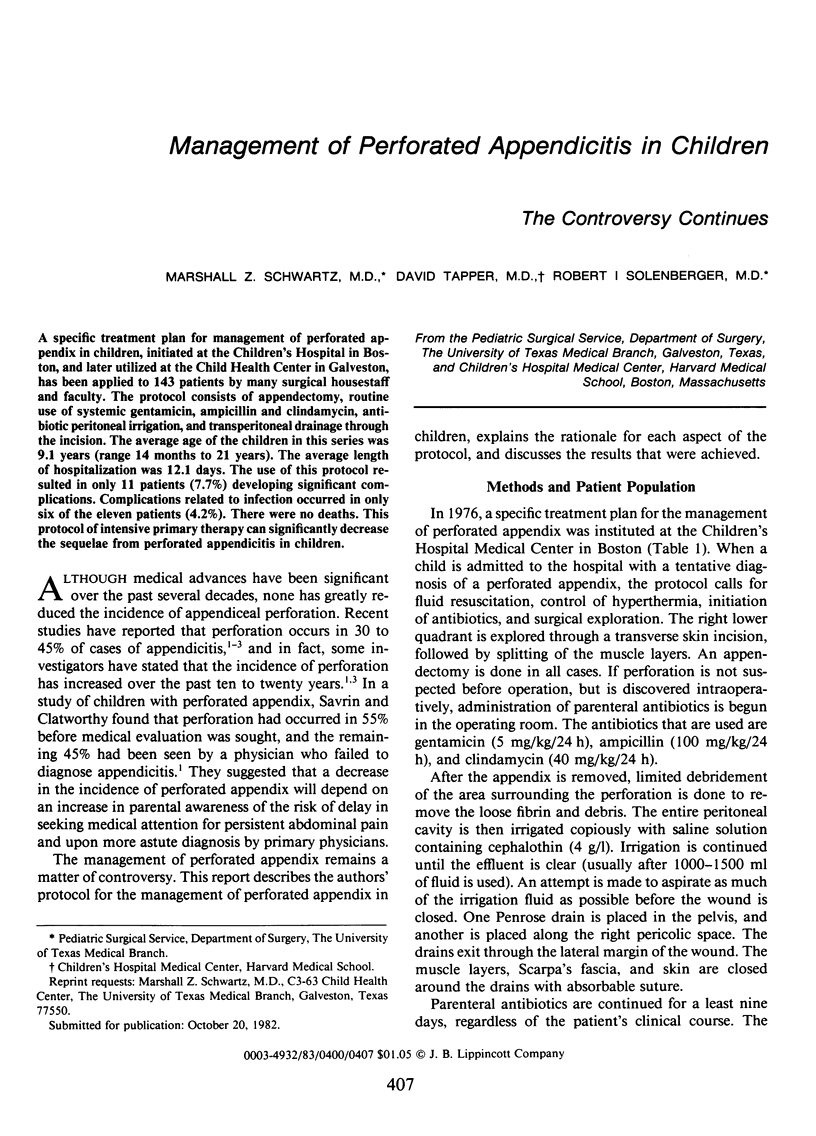
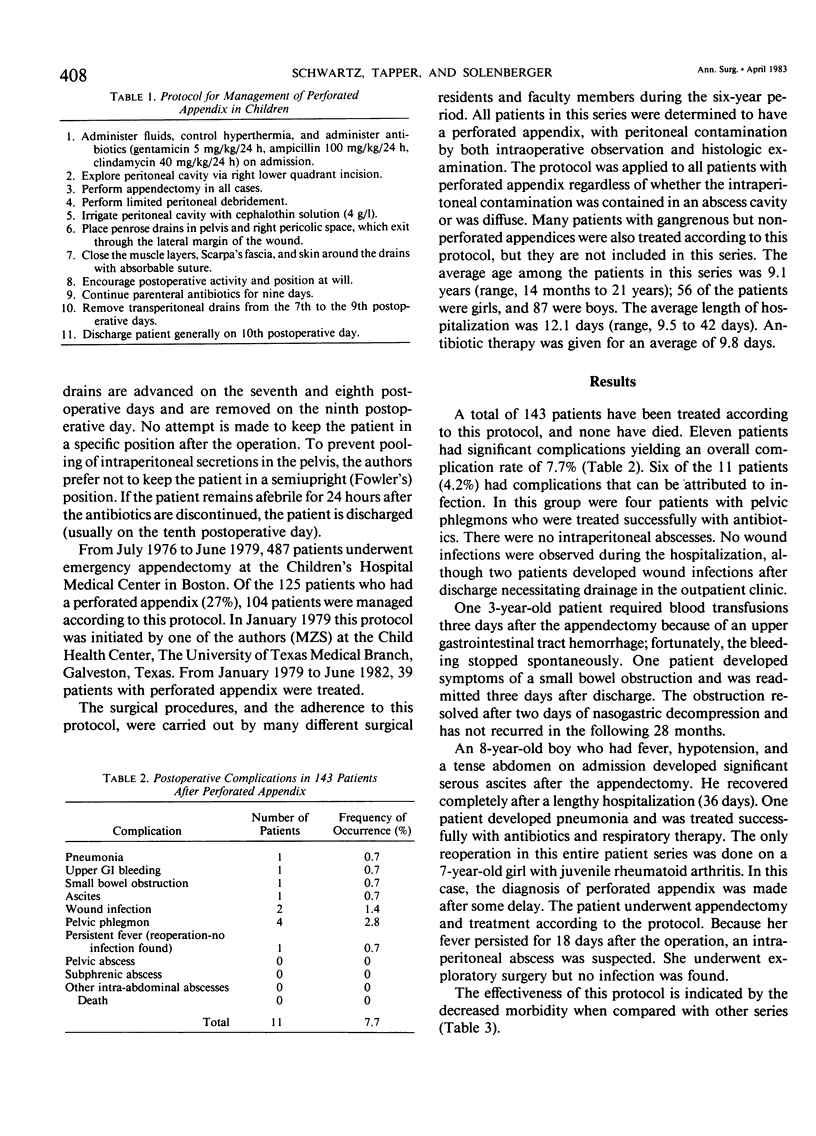
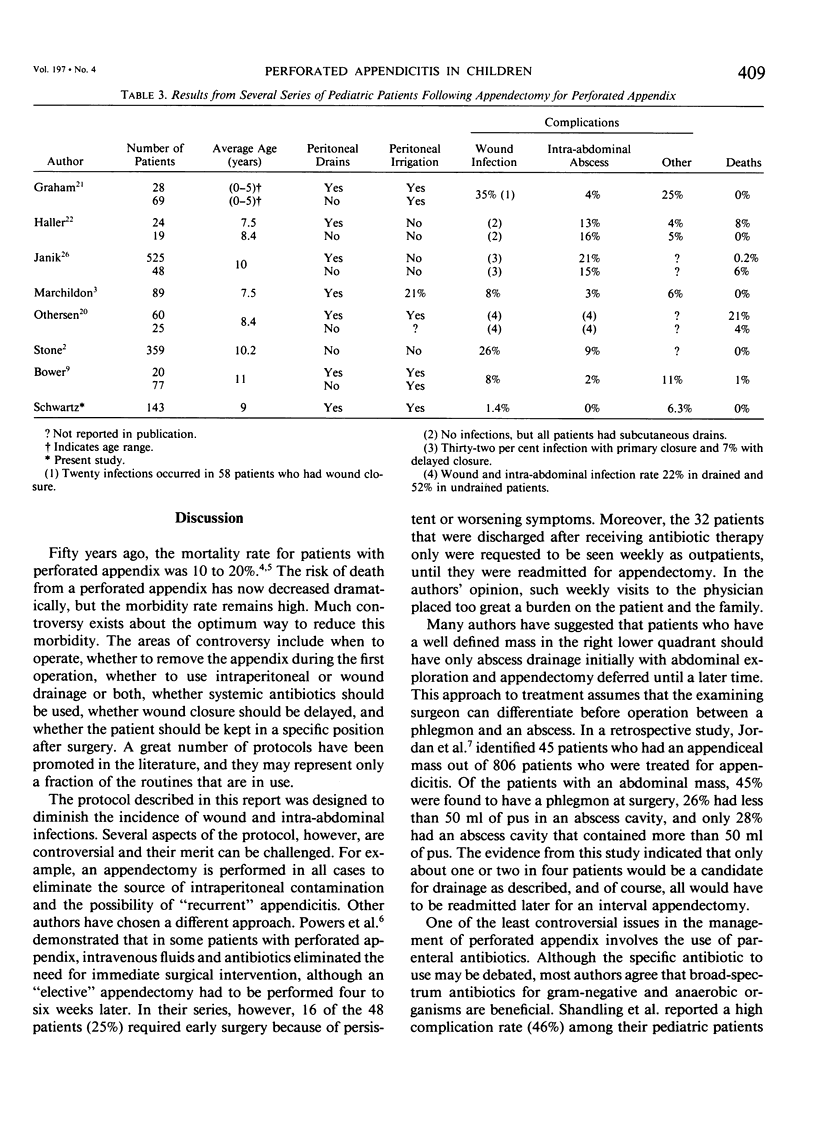
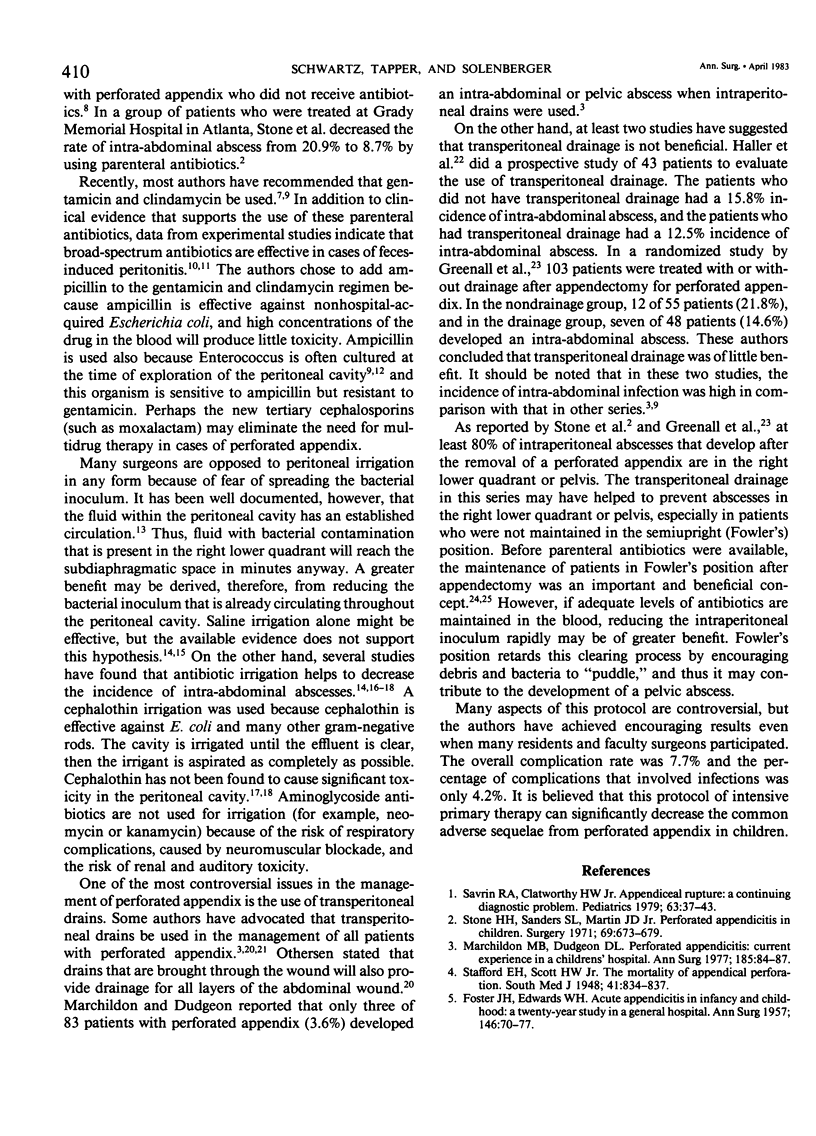
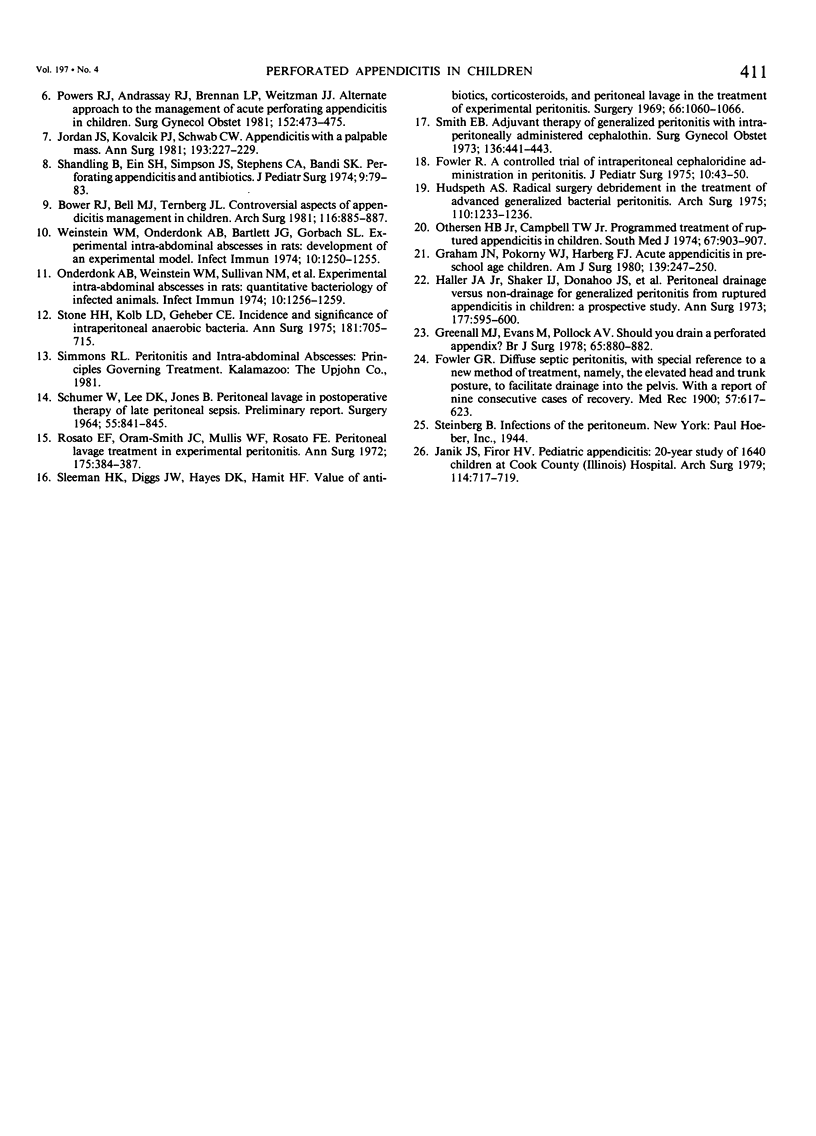
Selected References
These references are in PubMed. This may not be the complete list of references from this article.
- Bower R. J., Bell M. J., Ternberg J. L. Controversial aspects of appendicitis management in children. Arch Surg. 1981 Jul;116(7):885–887. doi: 10.1001/archsurg.1981.01380190025006. [DOI] [PubMed] [Google Scholar]
- FOSTER J. H., EDWARDS W. H. Acute appendicitis in infancy and childhood: a twenty year study in a general hospital. Ann Surg. 1957 Jul;146(1):70–77. doi: 10.1097/00000658-195707000-00008. [DOI] [PMC free article] [PubMed] [Google Scholar]
- Fowler R. A controlled trial of intraperitoneal cephaloridine administration in peritonitis. J Pediatr Surg. 1975 Feb;10(1):43–50. doi: 10.1016/s0022-3468(75)80007-8. [DOI] [PubMed] [Google Scholar]
- Graham J. M., Pokorny W. J., Harberg F. J. Acute appendicitis in preschool age children. Am J Surg. 1980 Feb;139(2):247–250. doi: 10.1016/0002-9610(80)90265-2. [DOI] [PubMed] [Google Scholar]
- Greenall M. J., Evans M., Pollock A. V. Should you drain a perforated appendix? Br J Surg. 1978 Dec;65(12):880–882. doi: 10.1002/bjs.1800651215. [DOI] [PubMed] [Google Scholar]
- Haller J. A., Jr, Shaker I. J., Donahoo J. S., Schnaufer L., White J. J. Peritoneal drainage versus non-drainage for generalized peritonitis from ruptured appendicitis in children: a prospective study. Ann Surg. 1973 May;177(5):595–600. [PMC free article] [PubMed] [Google Scholar]
- Hudspeth A. S. Radical surgical debridement in the treatment of advanced generalized bacterial peritonitis. Arch Surg. 1975 Oct;110(10):1233–1236. doi: 10.1001/archsurg.1975.01360160071012. [DOI] [PubMed] [Google Scholar]
- Janik J. S., Firor H. V. Pediatric appendicitis. A 20-year study of 1,640 children at Cook County (Illinois) Hospital. Arch Surg. 1979 Jun;114(6):717–719. doi: 10.1001/archsurg.1979.01370300071011. [DOI] [PubMed] [Google Scholar]
- Jordan J. S., Kovalcik P. J., Schwab C. W. Appendicitis with a palpable mass. Ann Surg. 1981 Feb;193(2):227–229. doi: 10.1097/00000658-198102000-00018. [DOI] [PMC free article] [PubMed] [Google Scholar]
- Marchildon M. B., Dudgeon D. L. Perforated appendicitis: current experience in a Childrens Hospital. Ann Surg. 1977 Jan;185(1):84–87. doi: 10.1097/00000658-197701000-00014. [DOI] [PMC free article] [PubMed] [Google Scholar]
- Onderdonk A. B., Weinstein W. M., Sullivan N. M., Bartlett J. G., Gorbach S. L. Experimental intra-abdominal abscesses in rats: quantitative bacteriology of infected animals. Infect Immun. 1974 Dec;10(6):1256–1259. doi: 10.1128/iai.10.6.1256-1259.1974. [DOI] [PMC free article] [PubMed] [Google Scholar]
- Othersen H. B., Jr, Campbell T. W., Jr Programmed treatment of ruptured appendicitis in children. South Med J. 1974 Aug;67(8):903–907. doi: 10.1097/00007611-197408000-00006. [DOI] [PubMed] [Google Scholar]
- Powers R. J., Andrassy R. J., Brennan L. P., Weitzman J. J. Alternate approach to the management of acute perforating appendicitis in children. Surg Gynecol Obstet. 1981 Apr;152(4):473–475. [PubMed] [Google Scholar]
- Rosato E. F., Oram-Smith J. C., Mullis W. F., Rosato F. E. Peritoneal lavage treatment in experimental peritonitis. Ann Surg. 1972 Mar;175(3):384–387. doi: 10.1097/00000658-197203000-00010. [DOI] [PMC free article] [PubMed] [Google Scholar]
- SCHUMER W., LEE D. K., JONES B. PERITONEAL LAVAGE IN POSTOPERATIVE THERAPY OF LATE PERITONEAL SEPSIS. PRELIMINARY REPORT. Surgery. 1964 Jun;55:841–845. [PubMed] [Google Scholar]
- Savrin R. A., Clatworthy H. W., Jr Appendiceal rupture: a continuing diagnostic problem. Pediatrics. 1979 Jan;63(1):36–43. [PubMed] [Google Scholar]
- Shandling B., Ein S. H., Simpson J. S., Stephens C. A., Bandi S. K. Perforating appendicitis and antibiotics. J Pediatr Surg. 1974 Feb;9(1):79–83. doi: 10.1016/0022-3468(74)90012-8. [DOI] [PubMed] [Google Scholar]
- Sleeman H. K., Diggs J. W., Hayes D. K., Hamit H. F. Value of antibiotics, corticosteroids, and peritoneal lavage in the treatment of experimental peritonitis. Surgery. 1969 Dec;66(6):1060–1066. [PubMed] [Google Scholar]
- Smith E. B. Adjuvant therapy of generalized peritonitis with intraperitoneally administered cephalothin. Surg Gynecol Obstet. 1973 Mar;136(3):441–443. [PubMed] [Google Scholar]
- Stone H. H., Kolb L. D., Geheber C. E. Incidence and significance of intraperitoneal anaerobic bacteria. Ann Surg. 1975 May;181(5):705–715. doi: 10.1097/00000658-197505000-00027. [DOI] [PMC free article] [PubMed] [Google Scholar]
- Stone H. H., Sanders S. L., Martin J. D., Jr Perforated appendicitis in children. Surgery. 1971 May;69(5):673–679. [PubMed] [Google Scholar]
- Weinstein W. M., Onderdonk A. B., Bartlett J. G., Gorbach S. L. Experimental intra-abdominal abscesses in rats: development of an experimental model. Infect Immun. 1974 Dec;10(6):1250–1255. doi: 10.1128/iai.10.6.1250-1255.1974. [DOI] [PMC free article] [PubMed] [Google Scholar]


